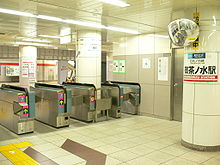- Ochanomizu Station
-
Ochanomizu Station御茶ノ水駅

JR East and Tokyo Metro station entrances Location Prefecture Tokyo
(See other stations in Tokyo)Ward Chiyoda Neighborhood etc. 2 Surugadai (JR East) (in Japanese) 東京都千代田区神田駿河台2丁目 History Year opened 1904 Rail services Station number(s) M-20 Operator(s) JR East, Tokyo Metro Line(s) Chūō Line (Rapid), Chūō-Sōbu Line, Tokyo Metro Marunouchi Line Statistics 107,205 daily[1] (JR East, 2007)
19.716 million annually (Tokyo Metro, 2007)[citation needed] passengers/dayOchanomizu Station (御茶ノ水駅 Ochanomizu-eki) is a railway station in Chiyoda, Tokyo, Japan, operated by East Japan Railway Company (JR East) and Tokyo Metro.
Contents
Location
JR East's Ochanomizu station lies next to the Kanda River. During the Edo period, the Kanda River was rerouted to pass through Ochanomizu, which was otherwise a highland between two valleys. Hijiribashi (聖橋, also known as Hijiri Bridge, Hijiribashi Bridge) crosses over the river near a station exit. The subway Marunouchi Line makes a short above-ground appearance as it passes over the river. Holy Resurrection Cathedral (Nicholai-dō) is easily accessible from the Hijiribashi Exit of this station. The Ochanomizu neighborhood is known for its many guitar and instrument shops.
The Tokyo Metro station is located in Bunkyō Ward, separate from the JR East station, and is served by the Marunouchi Line. The area is also served by the Chiyoda Line at Shin-Ochanomizu, which is connected to Ogawamachi station on the Toei Shinjuku Line.
Station layout
JR East
The JR East portion of the station has two island platforms serving four tracks.[2] Tracks 1 and 4 (the outer tracks) serve trains on the Chūō Rapid Line whilst tracks 2 and 3 are used by trains on the Chūō-Sōbu Line.[2]
1 ■Chūō Line (Rapid) for Shinjuku, Tachikawa and Takao 2 ■Chūō-Sōbu Line for Shinjuku, Nakano and Mitaka 3 ■Chūō-Sōbu Line for Kinshichō, Funabashi and Chiba 4 ■Chūō Line (Rapid) for Tokyo There are two exits from Ochanomizu to street level. The larger of the two is the Ochanomizu-bashi exit on the western end of the station which features ticket vending machines, a JR reservation office, toilets, and lockers. The other is the Hijiri-bashi exit which only has ticket vending machines and bathrooms.[2]
Ochanomizu is the second stop after Tokyo Station on the Chūō Line and one stop before Akihabara Station when travelling from Shinjuku.
Tokyo Metro
The Tokyo Metro station consists of two side platforms serving two tracks.[3]
1 ○Marunouchi Line for Tokyo, Ginza, Shinjuku and Ogikubo 2 ○Marunouchi Line for Kōrakuen and Ikebukuro Adjacent stations
Preceding station JR East Following station toward ŌtsukiChūō Rapid Line toward Tokyotoward MitakaChūō-Sōbu Line toward ChibaPreceding station Tokyo Metro Following station toward IkebukuroMarunouchi Line Awajichōtoward OgikuboGallery
History
The JR East station opened on 31 December 1904.[4] The Tokyo Metro station opened on 20 January 1954.[5]
References
- ^ JR East fiscal 2007 passenger figures Retrieved on 20 January 2009. (Japanese)
- ^ a b c Ochanomizu station map JR East Retrieved on 13 January 2009
- ^ Ochanomizu Station diagram Retrieved on 4 September 2009. (Japanese)
- ^ JR East station information Retrieved on 4 September 2009. (Japanese)
- ^ Terada, Hirokazu (July 2002). データブック日本の私鉄 (Databook: Japan's Private Railways). Japan: Neko Publishing. pp. 213. ISBN 4-87366-874-3.
External links
- JR East station information (Japanese)
- Tokyo Metro station information (Japanese)
Stations of the Chūō-Sōbu Line (Local Service) Chiba - Nishi-Chiba - Inage - Shin-Kemigawa - Makuhari - Makuhari-Hongō - Tsudanuma - Higashi-Funabashi - Funabashi - Nishi-Funabashi - Shimōsa-Nakayama - Motoyawata - Ichikawa - Koiwa - Shin-Koiwa - Hirai - Kameido - Kinshichō - Ryōgoku - Asakusabashi - Akihabara - Ochanomizu - Suidōbashi - Iidabashi - Ichigaya - Yotsuya - Shinanomachi - Sendagaya - Yoyogi - Shinjuku - Ōkubo - Higashi-Nakano - Nakano - Kōenji - Asagaya - Ogikubo - Nishi-Ogikubo - Kichijōji - Mitaka
Stations of the Chūō Line (Rapid) Tōkyō - Kanda –
Manseibashi- Ochanomizu – Yotsuya – Shinjuku – Nakano – Kōenji – Asagaya – Ogikubo – Nishi-Ogikubo – Kichijōji – Mitaka – Musashi-Sakai – Higashi-Koganei – Musashi-Koganei – Kokubunji – Nishi-Kokubunji – Kunitachi – Tachikawa – Hino – Toyoda – Hachiōji – Nishi-Hachiōji – Takao – Sagamiko – Fujino – Uenohara – Shiotsu – Yanagawa – Torisawa – Saruhashi – ŌtsukiStations of the Tokyo Metro Marunouchi Line Ogikubo - Minami-Asagaya - Shin-Kōenji - Higashi-Kōenji - Shin-Nakano - (Hōnanchō>>)Nakano-sakaue - Nishi-Shinjuku - Shinjuku - Shinjuku-sanchōme - Shinjuku-gyoemmae - Yotsuya-sanchōme - Yotsuya - Akasaka-mitsuke - Kokkai-gijidōmae - Kasumigaseki - Ginza - Tokyo - Ōtemachi - Awajichō - Ochanomizu - Hongō-sanchōme - Kōrakuen - Myōgadani - Shin-ōtsuka - Ikebukuro
Hōnanchō Branch Line
Hōnanchō - Nakano-fujimichō - Nakano-shimbashi - Nakano-sakaue - (>>Shinjuku, Ginza, Ikebukuro)Coordinates: 35°41′59″N 139°45′50″E / 35.69972°N 139.76389°E
Categories:- Railway stations in Tokyo
- Railway stations opened in 1904
- Stations of East Japan Railway Company
- Chūō-Sōbu Line
- Sōbu Main Line
- Chūō Main Line
- Tokyo Metro Marunouchi Line
- Stations of Tokyo Metro
Wikimedia Foundation. 2010.





